|
|
Post by chadwilliam on Apr 15, 2020 15:42:26 GMT -5
Why were The Golden Age Flash and Green Lantern forgotten? Because DC assumed that few of their readers would even remember a character from 1951 when they rolled out a new version in 1956. My understanding is that Julius Schwartz wanted a more science-based Green Lantern as opposed to bringing back Alan Scott, whose version of the Green Lantern is a version which many people by their reckoning would likely conclude is more magic-based. I presume that rather than re-invent Alan Scott, they decided to re-invent Green Lantern altogether, and Hal Jordan was the result of that. Oh, I get that. I just mean why were they forgotten in a "We won't even need to worry about addressing those other guys since no one'll remember them" kind of way as opposed to "let's update these characters but come up with a way to explain what happened to the older ones" way. |
|
|
|
Post by electricmastro on Apr 15, 2020 16:16:05 GMT -5
My understanding is that Julius Schwartz wanted a more science-based Green Lantern as opposed to bringing back Alan Scott, whose version of the Green Lantern is a version which many people by their reckoning would likely conclude is more magic-based. I presume that rather than re-invent Alan Scott, they decided to re-invent Green Lantern altogether, and Hal Jordan was the result of that. Oh, I get that. I just mean why were they forgotten in a "We won't even need to worry about addressing those other guys since no one'll remember them" kind of way as opposed to "let's update these characters but come up with a way to explain what happened to the older ones" way. And I imagine fans writing in the late 1950s asking what happened to Alan Scott and Jay Garrick’s status in the DC Universe overall helped change that perception! |
|
|
|
Post by Prince Hal on Apr 15, 2020 18:05:26 GMT -5
My understanding is that Julius Schwartz wanted a more science-based Green Lantern as opposed to bringing back Alan Scott, whose version of the Green Lantern is a version which many people by their reckoning would likely conclude is more magic-based. I presume that rather than re-invent Alan Scott, they decided to re-invent Green Lantern altogether, and Hal Jordan was the result of that. Oh, I get that. I just mean why were they forgotten in a "We won't even need to worry about addressing those other guys since no one'll remember them" kind of way as opposed to "let's update these characters but come up with a way to explain what happened to the older ones" way. I'm thinking that they were essentially selling comics to an almost entirely new audience. The names belonged to DC and they gave the creators something to build on, and they may have figured that they might ring a bell with some readers, for whatever that was worth. |
|
|
|
Post by chadwilliam on Apr 16, 2020 14:30:42 GMT -5
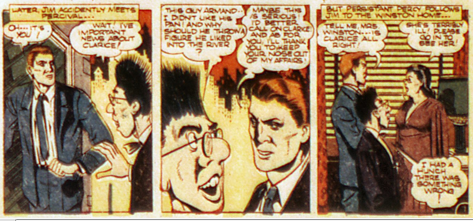
More Fun Comics #75 (January 1942)
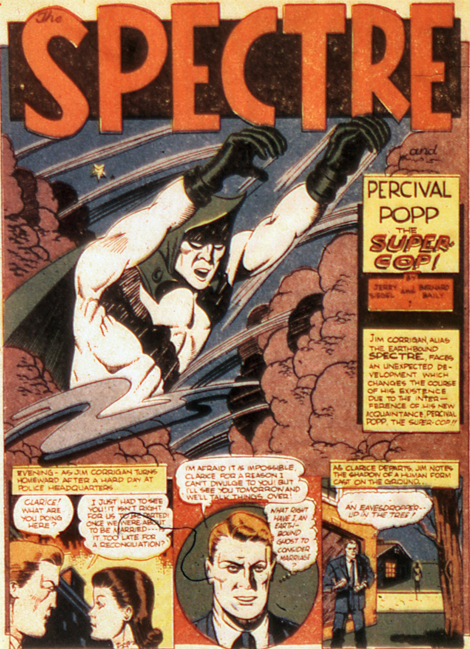
Synopsis: Within the span of only three panels, this entry begins with a reiteration of not only the status quo established in earliest appearance of The Spectre in this title but also of the status quo established last issue with the introduction of Percival Popp. As Clarice Winston once again asks Corrigan outside his home whether or not their relationship will ever culminate in marriage, our detective once responds that such a union is impossible for reasons he cannot divulge. “What right have I, an Earthbound ghost, to consider marriage?” Though lost in thought, Corrigan is not so distracted as to miss the fact that an eavesdropper lurks nearby. Cue Percival Popp in a tree. As persistent as he was in the previous issue, Popp tries convincing the detective that the two should form a union of their own – that combining Popp’s “brains” and Corrigan’s “brawn”. Letting the pest know that he isn’t interested, Corrigan heads indoors and unbeknownst to him, has a third visitor paying him a call this evening. Escaped convict “Gat” Chenney, seeking revenge on the copper who “sen[t] me up for life”, scales the wall of Corrigan’s home. Sighted by Popp, the so-called “Super-Cop” intervenes and admittedly, puts up a pretty good fight against the scofflaw. The scuffle attracts the notice of Corrigan who transforms into The Spectre who promptly chucks Chenney into space. Feeling that his debt is paid to Popp for fighting on his behalf, The Spectre reserves a somewhat gentler fate for the nuisance. Dropping Popp off on the ring of a planet “a couple of million light years” away, The Spectre returns home for peaceful sleep. Awakening the next morning, Corrigan can’t help but feel as though something important has slipped his mind. Cut to Percival Popp isolated on that distant planet being approached by a strange looking, I don’t know, green armadillo lizardy thing. “I’ve got it! Percival! I left him marooned up on that planet!” Though a caption assures us that The Spectre “streaks” back to Popp’s location, a comment the unfortunate visitor makes about having to run from that odd creature “for hours” suggests he might have actually taken his time in getting back to the fellow. Oh well, that creature apparently “just wanted to be friendly” anyway. 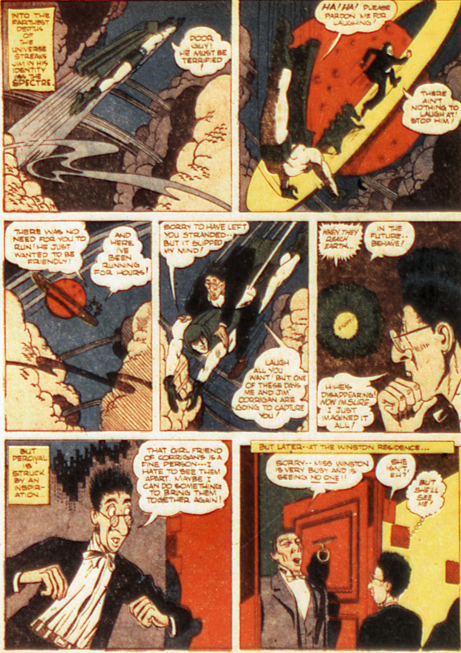 So Popp is dropped off on Earth, given a warning to behave, and then promptly heads off to The Winston household to see if he can get Clarice and Jim together once more. Sneaking into her home as she’s having her portrait painted by an artist named Armand, Clarice seems far more receptive to Popp than either halves of The Spectre are when the Super-Cop announces his intention to “bring [Corrigan] to his senses!” First however, Popp decides to trail Armand after deciding that he “doesn’t like his looks!”. Popp’s intuition seems on the money when he watches the artist drop a metal figure into the river. Reporting this information to Corrigan who, though insistent that Popp stop meddling in his affairs nevertheless agrees that his would-be partner may be on to something, Popp somehow gets into The Winston home alongside the detective. The elder Mrs. Winston entreats Corrigan to see her daughter who now lays in a coma. The Spectre discovers the source of her predicament when he looks at the portrait now residing in Armand’s hotel room. “The face – as real as life! And it is life! Clarice’s soul – imprisoned on that canvas!” Following a sudden urge to check in on Popp however, reveals to The Spectre that his obnoxious stalker is about to dive in after the metal figure Armand tossed into the river. It’s an area The Spectre knows well since it is also the precise spot where Jim Corrigan lost his life at the hands of “Gat” Benson way back in More Fun #52. Recognizing the implications of Popp discovering the corpse of Jim Corrigan, The Spectre races to the scene. “At the bottom of the river, The Spectre sorrowfully regards the figure imprisoned in a barrel of cement…” “Myself… slain by gangsters!”  With this, The Spectre raises his arms to the sky and requests “the power… the permission!” While it may not be immediately clear what this means, it appears that his pleas are understood by The Voice. Granting The Spectre his wish – “for you have done well on Earth” – The Voice bestows unto its prodigy the ability to restore Jim Corrigan back to life. The Spectre fades and Corrigan thanks his lucky stars. Rising to the surface and appreciative even of the bursting feeling in his lungs as he continues his journey upwards, Corrigan is grateful to once more be alive. Upon breaking the surface, Corrigan finds himself knocking heads with Popp as the latter jumps into the water. Explaining his presence by pointing out that he needed to retrieve Armand’s statue (which he has) Corrigan finds that Popp isn’t the only one present on the scene. Brandishing a gun, Armand demands the return of the figure which Corrigan offers to him. Asking what its purpose is, Armand explains that it is all part of a ritual enabling him to capture real life on canvas even at the cost of the sitter’s soul. Enraged, Popp lunges at Armand who promptly clubs him on the head before turning his attention back to Corrigan. With Popp unconscious, Corrigan seems ready accept that having once again been granted life, he is about to lose that gift a second time once Armand’s bullets reach their target. However, Corrigan is relieved to discover that the bullets pass through him harmlessly. Quickly dealing with the artist by vanishing him out of existence, The Spectre returns to his human form and informs the awakening Popp that while Armand has escaped, “I don’t think we’ll see him anymore!” The story draws to a close with Clarice and Jim arm in arm watching the moon together. Popp looks on and remarks “Just like the happy ending of a story!!” 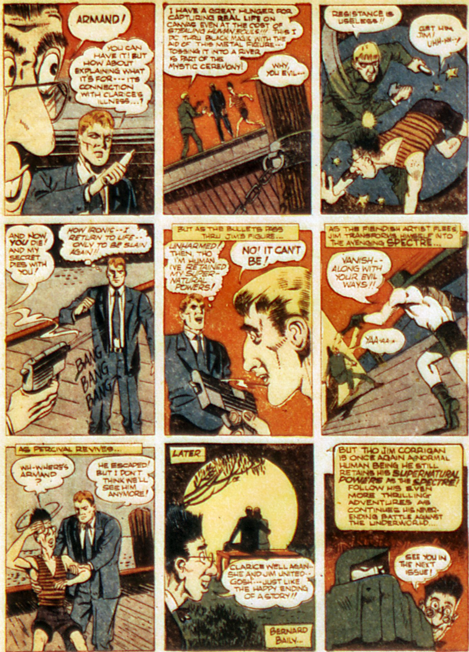 Thoughts Thoughts: What a weird time to revisit the origin of Jim Corrigan. Though I wouldn’t cite the introduction of Percival Popp to these pages as the point at which The Spectre lost his dark, sombre tone, you wouldn’t think that an issue featuring the brillo haired, goofy eyed, exaggeratedly bespectacled, “comic” stylings of Percival Popp would also contain a panel with The Spectre viewing his own corpse with sadness in his eyes. Interestingly, said corpse is actually depicted as an arm protruding from a barrel just as it was when last seen back in More Fun Comics #52. Though Baily doesn’t have Corrigan wearing the tuxedo he had on in that issue, it’s a nice odd to continuity especially since I can’t imagine too many readers would have necessarily recalled that detail. I suppose the tuxedo wouldn’t have made much sense in this issue either. “What were you doing down there, Jim?” “Same as you – looking for that statue!” “Why are you wearing a tuxedo?” “…” Recently, M.W. Gallaher made the rather prescient observation that when Michael Fleisher wrote his 1970’s Spectre run, he incorporated “little bits of this run”. With that in mind, he is an excerpt from 1975’s Adventure Comics #439 “ The Voice that Doomed The Spectre!” “I can’t go on this way! I can’t! Other men have wives and families! They get to experience the joys and pains of life! And when they die, they are granted the everlasting peace of eternal rest! But I have none of those things! I’m not alive… or dead! I’m some sort of lifeless thing, doomed to carry out some kind of awful,unearthly vengeance that I can hardly even understand! Please, release me from my mission! Let me be a real man again! Let me marry the woman I love! Please!” “When you awaken, Jim Corrigan, the humanity you thirst for shall once again be yours! Perhaps the mission I gave you… is indeed beyond the fulfillment of any one man! Perhaps being alive again will bring you happiness! I hope so!” 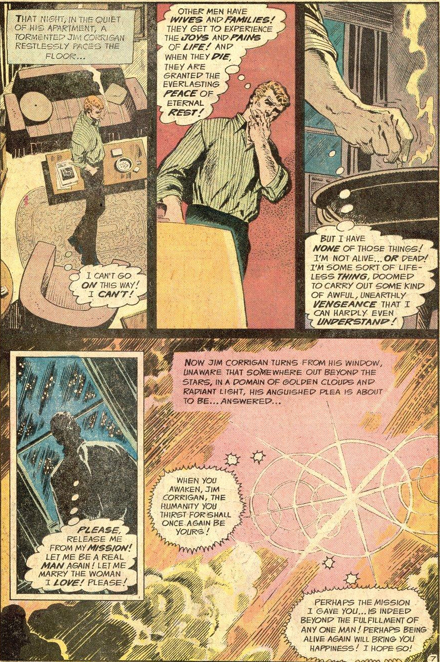 A little more eloquent than The Spectre’s “If you would give me the power – the permission!” from this issue perhaps, but surely the intent is the same. Incidentally, I suspect that having Corrigan discover that he is once again mortal in this issue by being shot in the arm while rushing a crook he assumes doesn’t have a chance against him (you see, Fleisher’s Voice didn’t fill Corrigan in on the fact that his humanity had returned) was inspired by a sequence in More Fun #54 where Corrigan does the same. In fact, I believe that The Voice not telling Corrigan that he could now be killed in Adventure Comics #439 was inspired by The Voice offering Corrigan a favour in these early More Fun issues only for there to be a nasty catch to it all (ie. you may have everlasting peace, but there’ll be nobody around to stop that bullet racing towards your fiancée). 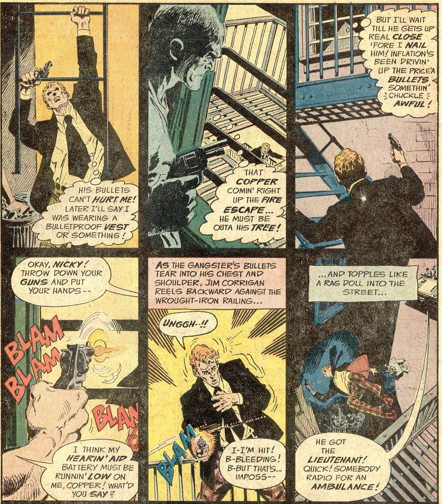 (don't worry - Corrigan does survive though with a wounded arm... this time) What else, let’s see… As much as I try to hate to Percival Popp, so far I only find him to be a mild annoyance. He’s presented more as a well-intentioned thorn in Corrigan’s side than as a broadly slapstick comic relief and for this reason isn’t as overpowering a presence as I first suspected he’d be. I still don’t quite understand why he’s here, but he feels more like an oddity than an anchor weighing things down. It helps that Siegel takes care to present Popp as surprisingly competent and avoids using him as the stereotypical cowardly klutz. Speaking of comic relief, it’s nice to see that The Spectre still has a bit of a sense of humour as evidenced by the fact that he has no qualms about dropping Popp off in the farthest reaches of space just to ensure a peaceful night’s rest for himself. Of course, the fact that Corrigan even needs to sleep despite our being previously informed that this is one of the comforts death has denied him, rather lessens the impact of his now being alive in way. In those early issues which established that Corrigan no longer needed to eat, sleep, or even breathe, it was clear just what he missed about being alive. Since at least some of those little touches have been forgotten about over time – “now for a quiet, peaceful sleep” remarks The Spectre – one has to wonder what he was deprived of in More Fun #52 that he hasn’t already reclaimed before this issue. To be fair, this installment makes it clear that unlike the ability to sleep, Corrigan never regained the ability to breathe until that was reinstated with his life. The big change however is that Corrigan no longer has any reason not to marry Clarice Winston. In fact, the final panel of this tale has the two silhouetted like a pair of young lovers against the moon. After two years of hearing Corrigan bemoan the fact that he can’t marry the woman he loves more than anything else in this world, I’m curious to see where things go. I’m pretty sure the two don’t end up married, but since Siegel seemed to be on the verge of simply excising Clarice quietly from the strip only to do a 180 here, I wonder if we’ll get, well, something happening instead. I mean, it would be pretty odd to just drop her from the series at this point. And another thing… Planets don’t have actual rings around them- well, not solid ones at least. They’re essentially ice and little bits of rock from what I understand and therefore, not the sort of concrete edifice on which Percival Popp can sit and wait for The Spectre to remember that’s not where he lives. Still, I like that Baily doesn’t care and even makes these rings the home of weird lizard like creatures. “There may be no lizard monsters on Saturn, but by golly there should be!!” I can hear him yell as he draws this. The scene is also a nice little reminder that while The Spectre’s code of ethics prevents him from hurting anyone who isn’t a bad guy, he’s still not someone you want to annoy as Popp does. You know, in re-reading that scene, I think I know how Corrigan’s trip back to whatever planet he dumped Popp off at could take only a few moments while at the seem time, seem to last for hours by Popp’s estimation. See – Corrigan thinks “Odd – but something important seems to have slipped my mind! If I could only remember what!” Cut to Popp spotting that alien creature. Cut to Corrigan snapping his fingers, “I’ve got it! Percival!” I’m now wondering if rather than making the connection between the memory he couldn’t quite recall and “I’ve got it! Percival!” almost instantaneously, several hours did actually pass between Corrigan realizing that he forgot something and remembering what it was, hence Popp’s line about “running for hours” from that animal. So concludes another issue. A lot to look forward to; a lot to worry about. What will happen with Clairce and Jim? What will happen with Popp? I guess we’ll start finding out next issue… |
|
|
|
Post by MWGallaher on Apr 16, 2020 17:15:19 GMT -5
With Jim still retaining his supernatural powers, even when not in his Spectre form, and retaining the ability to split into two, returning to life certainly seems like a formality without many practical consequences, although I guess we can assume that it just plain feels better in a way that those of us still among the living can't comprehend. I'd have expected that this development would introduce some kind of specific vulnerability, such as being either the magically powered Spectre or the completely human Corrigan at any one time, but Siegel didn't opt for that. At least not yet...
Your observation about Corrigan recovering more human qualities over the run, such as the ability to sleep, suggests another Roy Thomas-esque explanation: perhaps the mysterious Ring of Life (which I don't think appears any more in the series) was not only taming the Spectre's ruthlessness (as I suggested earlier), but was also gradually restoring him to vitality. The Voice was manipulating events to lead him to this unlikely reunion with his corpse, where it would culminate the revival process. While it probably wasn't Siegel's conscious intention, this does bring a sense of meaning to the arc thus far. We could even see Percival as a significant part of this reconstruction of soul, with Clarice giving him the renewed capacity for love and Popp the ability to establish friends, both crucial elements of humanity.
It's good to see that the series continues to mine Weird Tales territory for story elements like mystic statues and soul-capturing paintings. I expect that to peter out once Percival becomes the lead character.
|
|
|
|
Post by chadwilliam on Apr 20, 2020 16:59:19 GMT -5
More Fun Comics #76 (Feb, 1942)
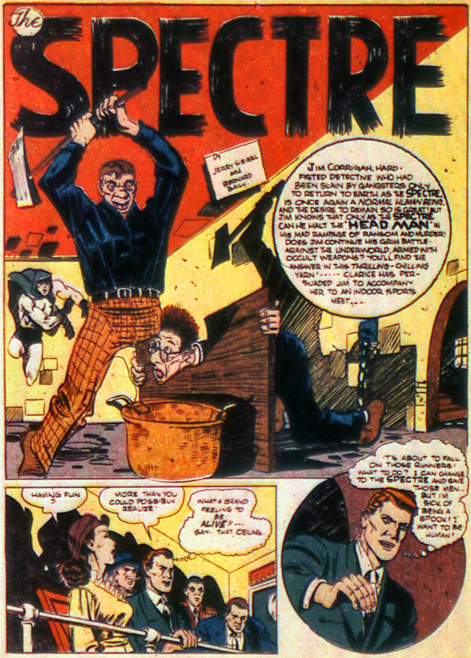
"I can change to The Spectre and save those men... but I'm sick of being a spook! I want to be human!"
Synopsis: Following the events of More Fun Comics #75 in which Jim Corrigan's life was restored without impacting his ability to operate as The Spectre, we find that rather than acknowledging the advantages which being a superhero affords, the detective can only resent the responsibility such power demands. When the ceiling begins to fall towards some runners at an indoor sporting match attended by Corrigan and Clarice Winston, the police officer considers his options. "I can change to The Spectre and save those men... but I'm sick of being a spook! I want to be human!" To his credit, Corrigan accepts that he can't allow these men to be harmed and rushes to action in the form of his ghostly alter-ego. Upon restoring the roof to its natural condition, The Spectre discovers that the ceiling was deliberated sabotaged. Before he can investigate further, he finds his attention distracted by a gunman taking a potshot at one of the runners on the field below. Dispensing with the thug as easily as he disappears from the police when they arrive upon the scene, The Spectre rejoins Corrigan and with Clarice in two, the detective asks one of the officers to shed some light on these chaotic events. He learns that having received a letter threatening trouble at the arena from a criminal who has Christened himself "The Head Man", headquarters has sent a couple of men down to investigate. When a panicked athlete informs the assembled mass that one of their runners, Nick Johnson, isn't responding to knocks on his locked door, Corrigan busts into the room and discovers a bound and gagged man in the closet. Johnson? No. "Percival Popp - The Super Cop!" Yes, once again, after overhearing the same conversation which brought these officers to this indoor arena, Popp has decided to barge upon the scene. Having arrived first, he managed to speak with the worried looking Nick Johnson who confided in Popp that he had been threatened by "The Head Man". Before the The Super-Cop could make further inquiries, he was slugged from behind, shoved into the closet, and well, here we are. Johnson's missing and somewhere there lurks a new foe for The Spectre dubbed The Head Man. Rejecting Popp's suggestion that they team up ("Stay outta my hair!!!" is actually how he puts it), Corrigan drives Clarice home oblivious to the fact that his number one fan has hidden himself in the back of his vehicle. Preparing to leave the Winston residence, Corrigan is accosted by a couple of armed men who invite him to visit The Head Man. "And whoever sees "The Head Man" don't live to boast about it!". Though Corrigan is pleased by this turn of events, Popp (unnoticed by the gunmen) doesn't cotton to the idea of his pal being taken for a one-way ride. He surprises the men and holds them at bay with their own revolvers. Not wanting his only lead to come to a dead end, Corrigan uses his occult powers to cause the guns to slip out of Popp's hands giving the men a chance to run for it, but not before the wanna be detective manages to snag one of their coats. 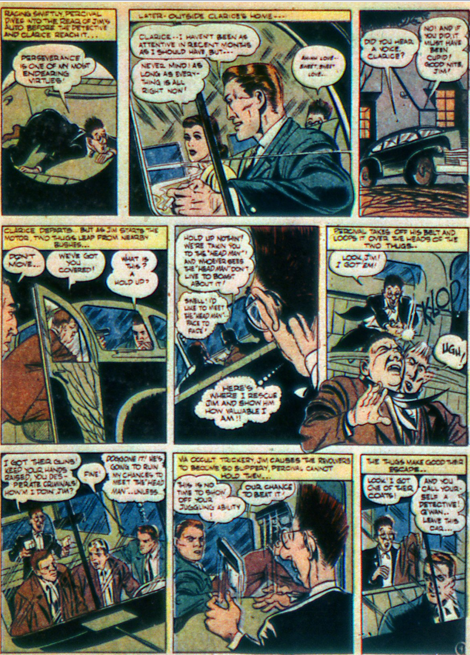 Kicking Popp out of the vehicle, Corrigan is free to give chase in his spectral form. Shrinking his own car and concealing it within his cloak, The Spectre leaves the abandoned automobile further down the road where it’s spotted by his prey. The car flies through the streets (literally about a foot off the ground though unbeknownst to them) as The Spectre gives chase. Arriving at a dance hall, The Spectre discovers that the men will be punished by The Head Man himself for failing to kill Corrigan. Unveiling himself from behind a curtain, The Head Man reveals himself to be a headless figure (albeit it one still capable of speech) and declares, “HAHAHA – HAHA-AAA! Scream, cowards, scream! You know my secret now! Why did I paradoxically name myself The “Head Man”? Why? Because I have no head!!! HAHAHA-HAHA-AA-AA!!!” Tossing the men into a pin, The Spectre plays his hand a little too late. The Head Man takes off behind a concealed wall and our hero turns his attention to a hidden cellar holding three men which until now, have held them captive. Recognizing one of the trio as a badly beaten Nick Johnson, The Spectre asks him his story and discovers that their captor had forced them to write him cheques after which he tortured them as if consumed by “an almost inhuman hatred”. With the men taken to Police HQ to tell their tale, The Spectre departs. Meanwhile, Popp has retrieved a slip of paper advertising the hall and with the clue in hand, heads to the scene. Having missed out on all the action, Popp blabs to one of the patrons that he’s on the look-out for “a super crook known as “The Head Man”!”. Word gets around to the fiend himself and Popp is invited to join a fellow sitting at a table in the club who offers him info. With his head strategically concealed by a vase of flowers, the man asks what Popp intends to do once he finds his target. “First, I’ll knock his teeth in! Then, I’ll sink my arm into his stomach – all the way up to my elbow! And if that doesn’t subdue him, I may resort to physical violence!” Although warned that there are rumours of The Head Man actually being headless, Popp isn’t deterred and continues to build himself up as a brave man even as he’s advised that no one who ever sees The Head Man lives long enough to tell. At this point, it occurs to Popp that he hasn’t even seen his informers face. Removing the vase, The Head Man tells him to “Have a good look!” at which point the Super-Cop faints. 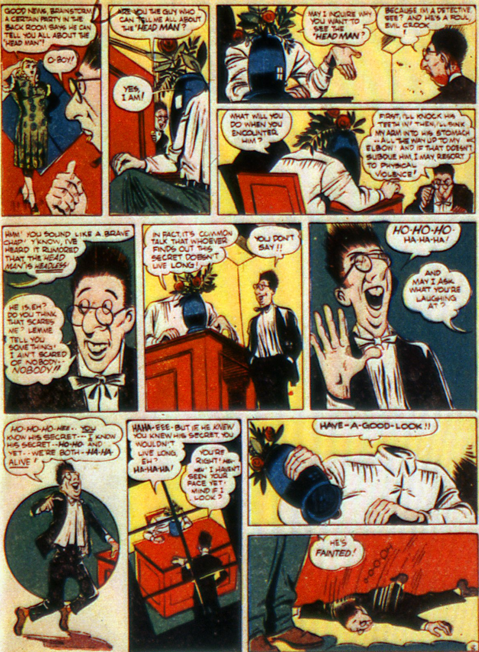 When he’s tossed into a pit filling with water, The Spectre senses Popp’s predicament and heads to the scene. Rescuing the pest, The Head Man makes the mistake of rushing towards Popp intending to send him back down the hole. Sidestepping the charging figure, The Head Man lands on a rocky outcropping crushing his chest. Retrieved by The Spectre and with but moments to live, our hero makes a startling discovery when he opens The Head Man’s shirt. Beneath his clothing is “a tiny knob of a head” probably no more than three or four inches in height. Explaining that he was always jealous of others who had “strong” bodies, The Head Man reveals that he was never really after money but responding to “the desire to kill – maim”. The Head Man dies, The Spectre flies off, and Popp calls the police. We last see Popp imploring Corrigan that he accept his proposition of working together which the detective once again rejects. The tale ends with a note from Siegel and Baily reading:
“Dear readers: Would you like to see Percival Popp and Jim Corrigan teamed together? Please write to The Spectre c/o More Fun Comics 480 Lexington Ave. New York City”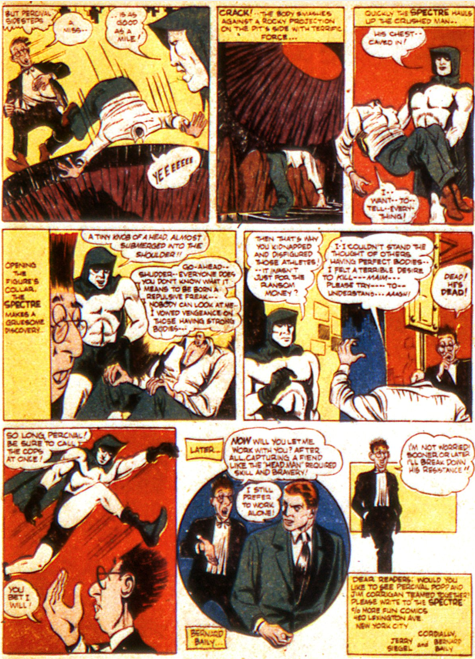 Thoughts Thoughts: To recap, an important development occurred in the previous issue with two potentially major repercussions. Jim Corrigan has been returned to the land of the living and The Spectre doesn’t seem any worse for it. That’s the first repercussion. The second is that Corrigan is now absolved of the reason he has previously given himself and Clarice for not going through with their planned marriage. To be honest, I wasn’t sure that this development or the fall-out from it would even be addressed going forward. Jim Corrigan has bemoaned the fact that he isn’t technically alive, but aside from references to no longer needing to sleep, breathe, or eat (and of those three, we know that he does sleep as evidenced in the previous issue) I’m not sure how restoring these activities really adds much to a series especially as it seems to be headed in a broader direction than before. Corrigan’s “Good Lord! I don’t breathe!” epiphany in More Fun #53 was a genuinely startling and powerful moment, but a nuanced touch for a series which doesn’t really delve into nuance any more. “Good Lord! I can taste this rutabaga!” “Good Lord! I can urinate again!” aren’t really lines I’m expecting to hear in this series. If Corrigan were perhaps vulnerable in his human form, that would be one thing, but if even Siegel lost interest enough in Corrigan not being able to eat, sleep, and breathe to mention it, why would I expect him to remember to have Corrigan remark on how he can now do these little things going ahead? But the other ramification – his relationship with Clarice – isn’t as easy to overlook. Given the brevity of the Corrigan/Clarice/Spectre triangle when first introduced before being quickly abandoned/referenced again/forgotten about/referenced again, I wasn’t sure it was a given that we’d be seeing the young Mrs. Winston again despite the happily ever after ending we got last time. Yet, here they are together at a sporting event. She’s still just an accessory to Corrigan and no mention is made of their wedding being back on or anything like that, but, well, she’s there. Corrigan does seem to be on the verge of saying something when he drives her home and remarks “Clarice – I haven’t been as attentive in recent months as I should have, but---“ only to have her assure him that nothing further needs to be said “as long as everything is alright now”. For the record, I’ve never really cared about the love lives of any superhero – why I was supposed to care if Lois Lane settled down with Superman or Batwoman with Batman was beyond me – but having set up this plot point, I’d like to see Siegel either do something with it or just forget about it altogether. Right now, it seems as if things might be developing, but who knows? A unique enemy for The Spectre, in that he’s the first physically odd villain who is also human, The Head Man reminds me of something Jack Cole might have come up with for Plastic Man. Over the top in our world, but perfectly suited to the environs of comic books, he’s one of those theatrical bad guys who operates without mercy but is borne out of tragedy and never does anything undramatically. That he could hold a conversation with Popp without the fellow catching on to the fact that his informer has no head due to a carefully placed vase is a bit silly, but worth it for the payoff. However, Popp’s stupidity and bravado during this scene is the sort of comic relief I was worried we’d be getting from the character. Thus far, he’s been surprisingly competent and not prone to pratfalls and slapstick – more a character with an overblown sense of self-worth than an in-your-face obstacle you’re trying to read around. If there is one thing I don’t like about this tale it’s the consideration Corrigan gives to doing nothing as the roof starts to cave in at the start of this piece. “I can change to The Spectre and save those men – but I’m sick of being a spook!” I can understand not wanting to rescue cats from trees or something, but he can’t spare a minute to save lives? How about “I can stay as Jim Corrigan and save those men – since that’s my job as a police officer!” then? In an earlier post, I noted that Corrigan’s original disposition as an brutish and rude thug seemed to actually wane once he died. Now that he’s alive again, it seems to be making a comeback. “Stay outta my hair!”, “And you call yourself a detective! G’wan… leave this car!” he snaps at Popp even being reprimanded by Clarice at one point to “Keep your temper.” As mentioned, the last panel asks readers to submit their thoughts on whether Popp and Corrigan should team together”. I suppose responses were favourable to the idea and the character stuck. I can sort of see why – Corrigan has to save someone as The Spectre but first has to get this pest off his back. Anything that makes the hero have to work harder has its appeal and this is one roadblock Corrigan can’t permanently shove aside. No request for thoughts on Corrigan and Clarice’s relationship though. Wonder what readers would have wanted to see there.
|
|
|
|
Post by chadwilliam on Apr 24, 2020 19:25:04 GMT -5
More Fun Comics #77 (March 1942) “ Death Rules The Elements!” 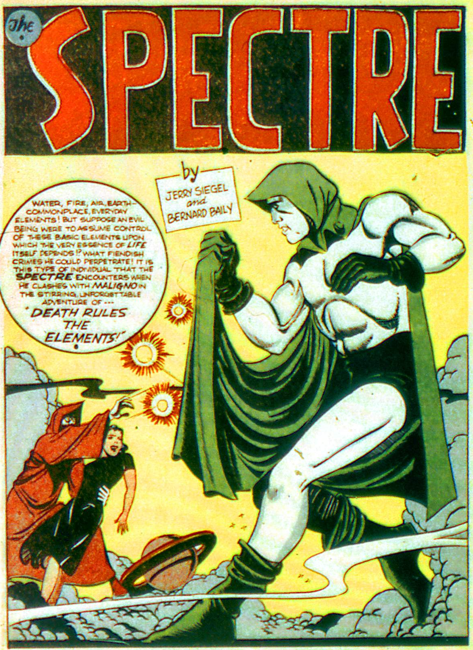 "Die bravely, eh? When the air slowly leaves your throat -- and you gasp for air which isn't there - and you writhe in agony -- die bravely, eh?"Synopsis "Die bravely, eh? When the air slowly leaves your throat -- and you gasp for air which isn't there - and you writhe in agony -- die bravely, eh?"Synopsis: A swimming pool of water evaporates in an instant leaving behind but a single word scorched onto its surface – Maligno! Flames engulf a new apartment building during its dedication ceremony just as The President of the company which constructed it boasts of its fireproof nature. Again, a single name is left scrawled on the only remaining wall of the building – Maligno! Boldly emblazoned along row of buildings is that same word again and within each edifice, not a single surviving soul. Who is Maligno? According to the Chief of Cliffland Police, the answer to that question is The Spectre. His top detective Jim Corrigan disagrees, arguing that “in my opinion, The Spectre fights on the side of law and order!” If the Chief intends to argue this point, he isn’t given the opportunity for at that moment, a strong wind blows a note through his window and on to his desk – “WARNING!! Unless I receive cash these disasters will continue!! You will hear from me again MALIGNO!” Vacating Corrigan’s body, The Spectre leaps through the window towards an indistinct shadow in the sky only to be struck back by a gale of wind. Though he manages to overcome this ominous force, he is unable to locate any leads upon continuing his search. Deciding to return to HQ, The Spectre rejoins Jim Corrigan and is introduced by The Chief to Professor Hunt “who has advised me in the past on puzzling cases like these!” despite never having appeared in the texts until now. Theorizing that the blame for these recent catastrophes can be laid at the of “someone [who] has gained mastery of the elements” Hunt also suggests that the police “not arouse his ire”. Agreeing to work cautiously, Corrigan can’t help but stand out (well, I guess he could help it if he chose to, but he doesn’t) when he transforms into The Spectre and heads to The Elkhart Reservoir where reports indicate trouble. Sure enough, upon arrival, The Spectre finds that the water in the reservoir has evaporated due to increasing heat from the sun. At this juncture, guards attempt to hold him for arrest but are stymied when The Spectre jolts them with a burst of electricity. Though he proceeds to reverse the effects of the sun thus returning the water to its source, the grim ghost is interrupted by Maligno himself (a red hooded, fanged being who looks not unlike Lon Chaney’s Phantom of the Opera) who advises him “to keep clear of my affairs!” 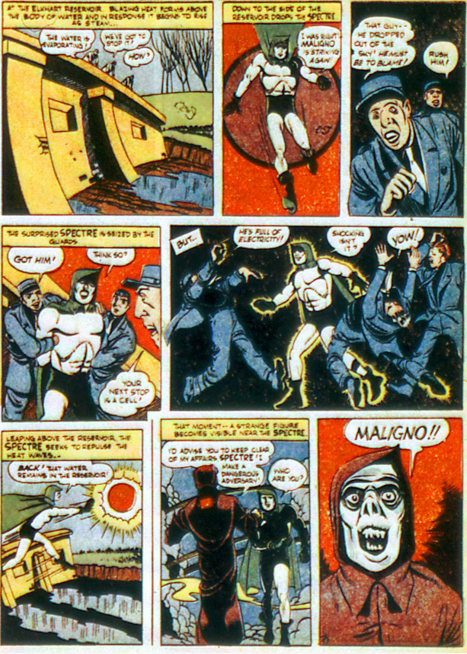 The confrontation is brief though, for Maligno succeeds in holding his foe at bay as the villain shrinks from sight. Once again, a supernatural adversary The Spectre is forced to concede is "even more powerful than I expected!" Returning home, Jim Corrigan receives a phone call from Prof. Hunt telling him that should he come to his laboratory, the good doctor will give him Maligno's true name. Corrigan obliges Hunt and when he comes face to face with the Professor, he is given a name - Marvin Joyce. According to Hunt, Joyce was a former employee who assisted in experiments not unlike those Maligno has made work to his advantage in recent days. Though unaware of any family Joyce may have, Hunt is able to provide Corrigan with the name of his fiancee, Louise Turner before a strange cloud engulfs him and the Professor vanishes. Following up the lead, Corrigan heads to Turner's residence where the young lady expresses her concern over a fiance she hasn't heard from in weeks. Before their discussion can develop further though, Turner is swept from the room by a powerful hurricane and into the clutches of Maligno. Though he follows, Maligno proves once again to be too much for The Spectre when he demonstrates the ability to materialize a planet in his path which then swallows our hero up. While he bursts free with little effort, The Spectre discovers that Maligno has once again escaped once again. Returning to headquarters, Corrigan is given the chance to face Maligno again when The Chief informs him that Cliffhand's latest threat has demanded a "gigantic ransom" (how gigantic isn't specified) which the detective himself is to deliver, "but you're to outwit Maligno and capture him!" (another detail which could probably use some expounding upon). So Corrigan delivers the money to Maligno's men, is taken for a ride, shot, and then dumped in a ditch. Transforming into The Spectre, our hero follows the men to Maligno's hideout where he discovers not just Louise Turner, but Marvin Joyce as well. As is standard for showdowns such as these, having lost the first two encounters, the good guy seems destined to win the third - a fact which Maligno seems aware of given how hastily he runs off after his bombardment of flames have no effect over the ghost. The Spectre catches up to Maligno, the two struggle, and our hero saves the day when he wrenches a box from his challenger's back which turns out to be the source of his command over the elements. Crashing into the Earth, Maligno changes into Professor Hunt who admits that having Joyce reject his offer that the two rob the blind using his element controlling invention, he decided to frame Joyce for his crimes. Uttering his regrets for his actions, The Spectre points out that the dying Hunt could have become rich and famous for his discovery. 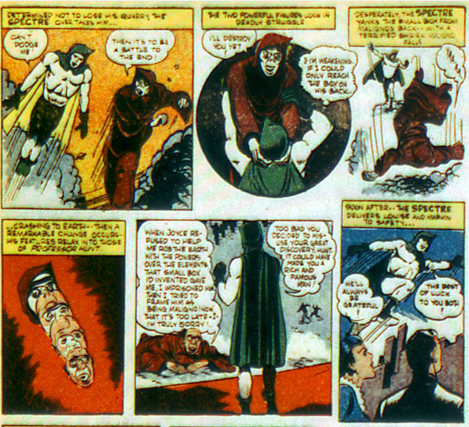 The Spectre is offered Turner and Joyce's thanks, he returns to the office as Corrigan, and is once again reminded that it is still his job to capture The Spectre. "If I can't keep track of The Spectre, Chief, no one can!" Thoughts: Though Doctor Fate and now The Green Arrow may have absconded with the honour to serve as More Fun Comics title feature, Bernard Baily provides The Spectre with a very exciting looking Splash page with this installment. Though it's only 1942, by playing up the dynamic though hesitant pose of The Spectre and even the brightness of his colours, the sparkling orbs flying towards him against a bright yellow backdrop, and the strong bold typeface presenting his name at the top of the page (as opposed to the scratchy ominous lettering utilized in, say, the previous issue) it's clear that this is a character who has undergone plenty of changes in his but two years of existence. Had the strip lasted longer, I would have guessed that this story dates to the Atom Age from the superheroic nature of the image. And yet, the tale hidden beneath it harkens back to days of old. There's no Percival Popp for one thing. Whether due to it dating back before the character's introduction or intended as a respite for a figure who Siegel and Baily seem willing to dismiss should audience reaction prove to be unfavourable about, the impressed conveyed is that should readers not prove amenable to Percival Popp, this is the sort of yarn they can come to expect in installments to come. Mysterious happenings; a hooded figure whose power seems to outmatch that of our hero; uncertainty about the villain's true identity; good guy losing first two rounds only to emerge victorious in the third with The Spectre pulling a rabbit out of his hat; ending with some attempt made to entice readers to return next issue by reminding us that it is Corrigan's job to capture his alter ego. Not a terrible formula and certainly not one limited to The Spectre. Other characters generally did it better by giving us a wider pool of suspects to select from when trying to deduce the villain's true identity whereas here, it's pretty obvious from the get-go that Hunt is Maligno (they even look alike and if Chief is willing to vouch for him then he must be guilty). Still, Maligno gets a powerful introduction by way of the catastrophes which precede him and the mystery which surrounds him isn't so much focused upon his true identity but upon the question of how he manages to do what he does. His focus on the elements of wind, water, and fire makes him The Spectre's earliest theme villain as opposed to being a bad guy just looking to cause as much mayhem as he can without any real direction. We're also expected to believe that the chaos he creates is the result of science and not black magic - a hard pill to swallow given the feats he performs even if you accept the scientific implausibility of making the contents of a reservior boil without scotching anyone within the vicinity to death. Towards the climax of this tale, Maligno almost overcomes The Spectre simply by strangling him. The Spectre wrenching the box on his back at the last moment is an act of desperation which works, but doesn't undo the fact that an ordinary human being with ordinary human strength, nearly managed to defeat a supernatural being simply by throttling him. Given the fact that The Spectre's power levels are all over the place, it's hard to know just what's a danger to him and what isn't. But these flaws aside, there is still much to enjoy about this tale. One page in (two, if you include that extraordinary splash) and already we have three separate fantastical events, a stunning looking villain (don't let my earlier "hooded figure" description underwhelm you, Maligno looks like a cross between Lon Chaney and a shark), and while the villain's identity is obvious from the start, Siegel does do a good job of having us question that certainty by seemingly do away with Hunt shortly after he divulges Joyce's name, and hey, Corrigan taken for a ride, shot, dumped in a ditch is the sort of thing a Spectre script doesn't necessarily need, but is one of those things I think you'd miss if it were gone. On a final note: Siegel has The Spectre on two occasions acknowledge that comic book logic doesn't always align with that in our world. First, when Corrigan gets an urgent call from Hunt professing that he knows who Maligno is, he doesn't race right over, but walks. Why? "I can be in the laboratory in an instant", he thinks, "but I'd better use the slower method to avoid suspicion!" Not the sort of forethought superheroes generally invest in their comings and goings. Usually we get "How did you get here so fast?" "er, um, ah, that is, I have my methods, er... ha...ha!" Second, when Maligno lays dying, The Spectre points out that he could have made more money lawfully through his invention than he could have stolen with it - again, the sort of insight you don't usually find in tales involving criminals using million dollar inventions to steal thousands. So, a fun tale and with the exception of the stories still to come in All-Star Comics, possibly the end of an era for The Spectre if Popp doesn't sit out any more adventures. Oh, and hey, these stories are now starting to get titles – “ Death Rules the Elements!” oohhh, good one.
|
|
|
|
Post by MWGallaher on Apr 26, 2020 14:36:33 GMT -5
One thing I find notable is that Baily, starting a while ago, has changed the way he renders the Spectre's hood, giving it a jaunty jutting point instead of having it droop down over his brow. Somehow it makes the character look friendlier and happier instead of sinister and threatening, more in keeping with the tone it is increasingly taking on. Curiously, he takes the same approach with Maligno, suggesting that this is not an intentional effect he's going for.
|
|
|
|
Post by chadwilliam on Apr 27, 2020 12:38:01 GMT -5
One thing I find notable is that Baily, starting a while ago, has changed the way he renders the Spectre's hood, giving it a jaunty jutting point instead of having it droop down over his brow. Somehow it makes the character look friendlier and happier instead of sinister and threatening, more in keeping with the tone it is increasingly taking on. Curiously, he takes the same approach with Maligno, suggesting that this is not an intentional effect he's going for. I've noticed that Baily has also changed The Spectre's mannerisms at least as far as it pertains to the way he now has a tendency to leap into the air rather than fly into it. He often looks as though he's kicking one leg out as far ahead of him as he can while trying to touch his toes on that foot with his other hand (see the penultimate panel in my review of More Fun #76 for an example). The impression created, is one of The Spectre more prancing through the sky than flying through it. Baily has also made the toes on his boots more pointed which at times, gives them a pixie-looking effect. Hardly becoming of a vengeful ghost. Of course, that might be more a result of Corrigan's sewing skills than anything else since we are supposed to believe that he sewed the outfit himself. |
|
|
|
Post by Rob Allen on Apr 27, 2020 13:13:02 GMT -5
Didn't Baily have a studio full of assistants? He might not have been drawing the Spectre himself at this point.
|
|
|
|
Post by chadwilliam on Apr 27, 2020 18:09:07 GMT -5
Didn't Baily have a studio full of assistants? He might not have been drawing the Spectre himself at this point. I don't know enough about Baily to know one way or the other, but seeing how his artwork developed over time (see, the horror work he did in the 50's posted earlier) I wouldn't be surprised if these changes were simply a result of him experimenting with new styles/adapting the feature to its more light hearted tone. Like I said though, I don't know and I really don't have the eye to tell. |
|
|
|
Post by chadwilliam on Apr 27, 2020 18:24:26 GMT -5
 
All Star Comics #9 (March 1942)
"Good riddance to such vultures! But too bad they took their secret with them!"   Synopsis Synopsis: Once again, The Justice Society is called before Washington’s Chief of the F.B.I. (ostensibly J Edgar Hoover, but his face is never shown). Crediting the team with the fine job they did in carrying out his orders before (see All-Star Comics #4) the Chief requests their aid in “Central and South America and Mexico” where totalitarian regimes have planted spies. As he explains: “The United States cannot act officially for obvious diplomatic reasons! It might be construed as an act of oppression by the twisted minds of the foreign dictators! Yet those spies must be weeded out and overcome! That’s where you come in!” Johnny Thunder picks up on his train of thought and continues: “I get it! The Justice Society can go down there and help clean up those rats, without involving The United States – we work under cover, and Uncle Sam can’t be accused of interference – whatta good idea!” “You hit the nail right on the head!” The team gets their individual assignments (at which point we learn all members speak Spanish save for Johnny Thunder) and The Spectre heads for Buenos Aires, Argentina. His mission? “Army planes disappearing mysteriously! Suspect fifth columnists responsible! Investigate!” At that moment, The Spectre catches sight of an army plane and decides to keep watch. Suddenly, a strange looking auto-gyro with seven metal arms appears and snatches the plane rising high enough up into the stratosphere to force its occupants to pass out from lack of air. Recognizing their plight, The Spectre frees them from their vessel and releasing their parachutes, enables the men to land safely upon the ground. Returning his attention to the strange autogyro itself, The Spectre enters the craft and finds it to be manned by a pair of Nazis. Accepting that they are no match for their strange visitor, the Captain of the vessel detonates the ship before The Spectre can force them to carry out his order to “take me to your leaders”. Thinking that Jim Corrigan might have better luck in acquiring a lead, the detective offers his services to the Argentine Secret Service where his reputation precedes him. Corrigan is informed that only today, they have captured the head of the spy ring our hero seeks. Accepting his request that he be allowed to tag along when the villain is flown to a military prison, Corrigan is on hand when another autogyro attempts to abscond with their craft. When the passengers begin gasping for air, Corrigan transforms into The Spectre, places the men into a trance in which “they won’t have to breathe”, and remains invisible as their plane is taken to a mountain in the Andes. There, the men are carried out of the craft (their trance-like state is mistaken for death), a swastika is added to its tail, and a fleet of autogyros ascend into the sky. The Spectre gives chase. Growing to enormous height, our hero follows the first ship to Buenos Aires where a bomb is dropped over the city. Impressively, The Spectre catches the weapon in his mouth and spits it back at its source. Capturing the rest of the vessels and returning the stolen planes, The Spectre streaks back to the Andes, transforms back into Corrigan, frees the Argentine agent, and when the two take down the rest of the spies, Corrigan’s mission is complete. Thoughts: I know these are only fictional stories and despite the occasional presence of real world issues and sometimes even real people in these tales I think it’s safe to assume that in the comic book world, we can take things at face value. Authority figures can always be trusted and characters and institutions presented as incorruptible and trustworthy are just what they seem in these tales. And I certainly have no problem with The Spectre going after Nazis, but… Knowing what we know now about how the real world Hoover ran the F.B.I. and about how America used underhanded tactics to overthrow democracies in places such as Guatemala and Iran to replace them with U.S. appointed dictators, it’s pretty unnerving to see how eager The JSA is to act as pawns without question. Johnny Thunder even suggests that the team make “chief an associate member of The Justice Society! He sure is one man who does a lot for law and order!”. The Spectre seconds the motion and the team gives Maybe-Hoover (‘Maybe’ because we don’t actually see his face) three cheers. Man, I know it was a different time and place and people certainly didn’t know then what they do now, but, well, I got a little sick of all the praise Maybe-Hoover kept getting from The JSA – it just seemed to go on and on. I’ll leave it at that.  At six pages, this is a shorter tale than usual and three quarters of the first page is devoted to a magnificent image of The Spectre towering over a fleet of planes. We’ve seen the character grow to enormous heights before, but I’m hard pressed to recall a sight as awesome as this. I suggested before that Baily relying on cartoonish looking planets and stars was a result of sidestepping the dilemma an artist encounters when a regular sized object is presented alongside a giant object – say, having the regular sized Spectre grab hold of a humongous body such as a star. Make one thing look big, the other thing runs the risk of looking comical or fake. Not so here – a 200 foot tall Spectre smashing planes against a black sky is an arresting image and one which I suspect would imprint itself indelibly upon later writers hence very similar looking images making their way into comics decades down the road. Honestly, its unashamedly celebratory tone of what The Spectre can done when let loose feels more like All-Star Squadron than All-Star Comics where panels and time tended to be more compact. The story itself is pretty straightforward though it’s always nice to see a superhero pound on some Nazis. While unusual, a fleet of autogyros making off with planes doesn’t have that added touch of the extraordinary Spectre tales require to be truly memorable. There are no memorable villains here either physically or characteristically, no plot that any superhero with the ability to fly could squash, and no real threat to our champion. It’s up to The Spectre to supply those details and there are a few on hand in addition to the afore mentioned splash. First, The Spectre rises from the bottom of the autogyro when he makes his first appearance in this piece. We’ve seen him fly and walk through walls, but there’s something about him rising from the ground which feels a little more weird and therefore a little more right. It’s a little touch, but effective considering that he should be more ghost than superhero in my estimation. Second, nice seeing that The Spectre can place people in a trance like state resembling death. Superman could do this of course to himself by stopping his heartbeat, but a good guy managing to do it to others? A neat trick and even something of a callback to the days when The Spectre might do this to a villain and just leave him stranded on the outer reaches of the universe. Third, The Spectre swallows one of the Nazis’ bombs and then spits it back at its source. Impressive and disrespectful at the same time. So a short story and to the point, but nice to see that little touches are still being added to the series. |
|
|
|
Post by chadwilliam on Apr 30, 2020 20:05:22 GMT -5
*****PLEASE NOTE - Though I'd rather my 'Thoughts' on this issue not be entirely disregarded, CEI-U! has brought my attention to the fact that Gardner Fox has been writing this series since More Fun Comics #72! Any references in my review here (or in any post-More Fun #71 issue, for that matter) to "Siegel's" script or "Siegel's" writing should act only to reflect my immediate thoughts upon reading these tales and be taken in that context*****
More Fun Comics #78 (April 1942) “The Magic Crimes!”
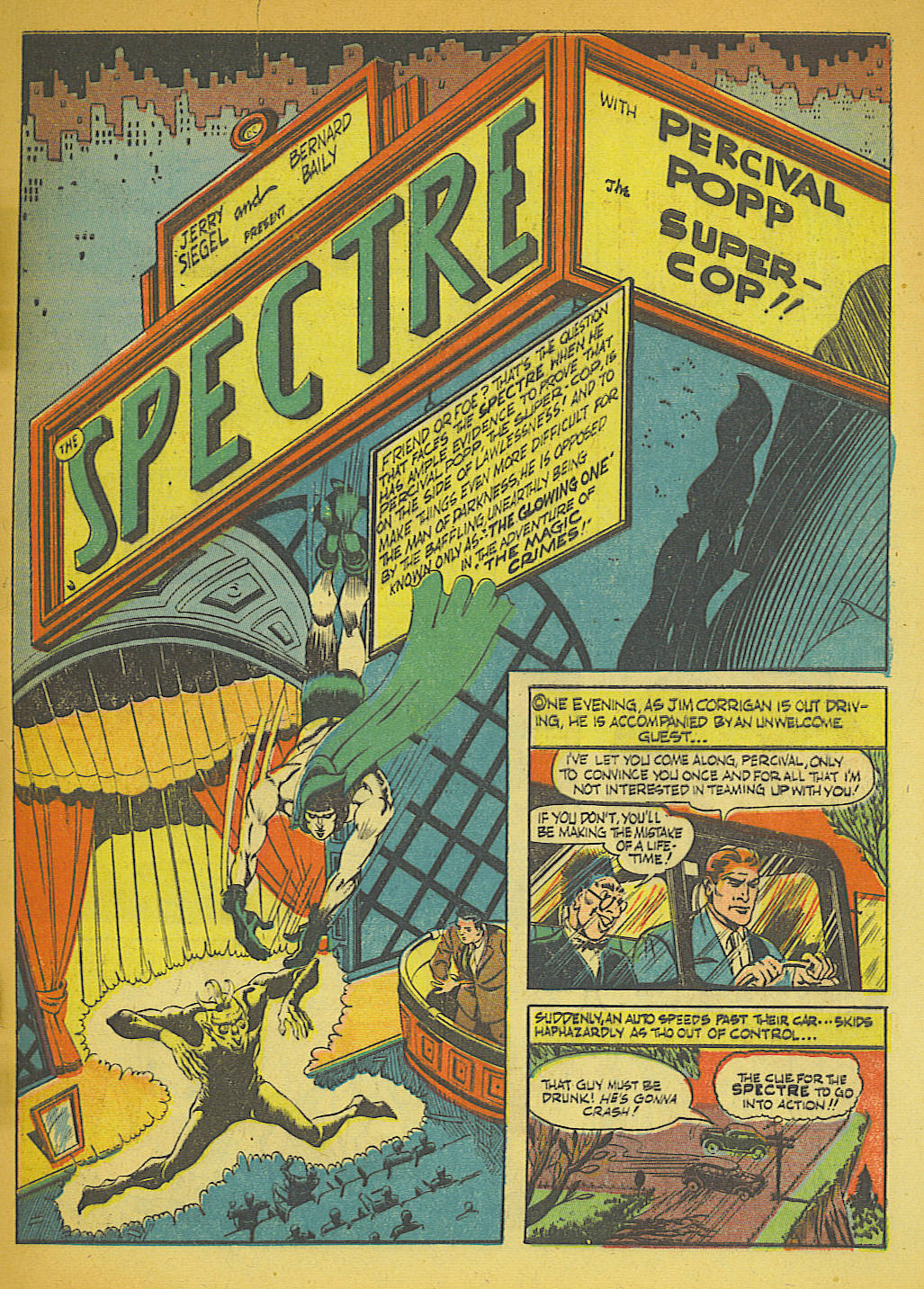
"Offer no opposition --- or you'll meet a fate that will make you wish a hundred times over that I'd been merciful enough to kill you outright!"Synopsis: “I’ve let you come along, Percival, only to convince you once and for all that I’m not interested in teaming up with you!” declares Jim Corrigan somewhat contradictorily as he and Percival Popp drive along the road. Before he can say anything more, an out of control vehicle cuts in front of their car, crashes into a telephone poll, and veers over a cliff. Transforming into The Spectre, the automobile is caught before it can hit bottom and placed back on the road allowing Corrigan to take over. Threatening to take the motorist in for reckless driving, Corrigan allows the man – a magician who goes by the name of Kati Lugi – to explain himself. According to Lugi, he was attempting to catch his assistant who has stolen some of his magic supplies. Though I don’t think most officers would be satisfied with this excuse, Corrigan accepts the explanation perhaps due to his sympathizing with the magician who cannot perform without an assistant and possibly due to Popp’s offer to stand in as Lugi’s partner providing him with a chance to get the meddler out of his hair for a while. Whatever the reason, Corrigan finds himself in attendance at The Midtown Theatre where Popp and Kati Lugi perform their feats of magic. “At least this ought to be amusing!” remarks the detective. As one has to come to expect whenever Corrigan is present, trouble arises in the form of a gigantic, glowing figure materializing in the theatre demanding “tribute!” The Glowing One, as he has Christened himself, steals the customary items in situations such as these – jewelry, watches, money – thus making himself a target for The Spectre. Although eager to do battle, The Spectre finds that The Glowing One doesn’t share his enthusiasm and promptly vanishes. Of course, this doesn’t let Jim Corrigan off the hook and he’s assigned to capture, who else, but The Spectre. “I’m certain that The Glowing One is nothing more than a trick pulled by our old foe, The Spectre!”, blusters The Chief.  Over the ensuing days, the city is deluged with a variety of robberies carried out by The Glowing One and it isn’t long before Corrigan gets a lead. After literally tossing a group of the villain’s thugs into a patrol wagon following their attempted robbery of Platt Brothers (which might be a jewelry store – it’s not made very clear) Corrigan returns to the scene of the crime and questions the proprietor. Popp barges onto the scene, declares that he’ll do the questioning, and when he asks for a description of The Glowing One (who was apparently on scene before his men took over) is told “He was short! He had a long nose! A large mop of hair… may have been wearing glasses under the mask!!” Summoning up a vision of the crime only confirms for Corrigan that the shop owner’s description matches that of Popp to a T. Denying any involvement in the matter, Popp suggests that they seek advice from Kati Lugi. A visit to his home follows and Lugi regretfully theorizes that he may be to blame for The Glowing One’s existence. “You see – I am very interested in occult studies! In my experiments with demonology I may have released this physical fiend from the spirit world!” Expressing his sincere regret and his hope that this may not be the case, the magician leaves Corrigan and Popp with something to chew over. Shortly after departing, the pair are set upon by a group pf hoods. Though Corrigan manages to fight them off, he finds himself in a tough spot when a gun pokes into his back. Tougher still, when he turns to see that the weapon is being brandished by Popp. Corrigan: Percival! Popp: That’s right! Keep ‘em raised, Corrigan! Corrigan: Then -- then you do work for The Golden One! Popp: I sure do! And now that you’ve found out – my next move is to kill you!! 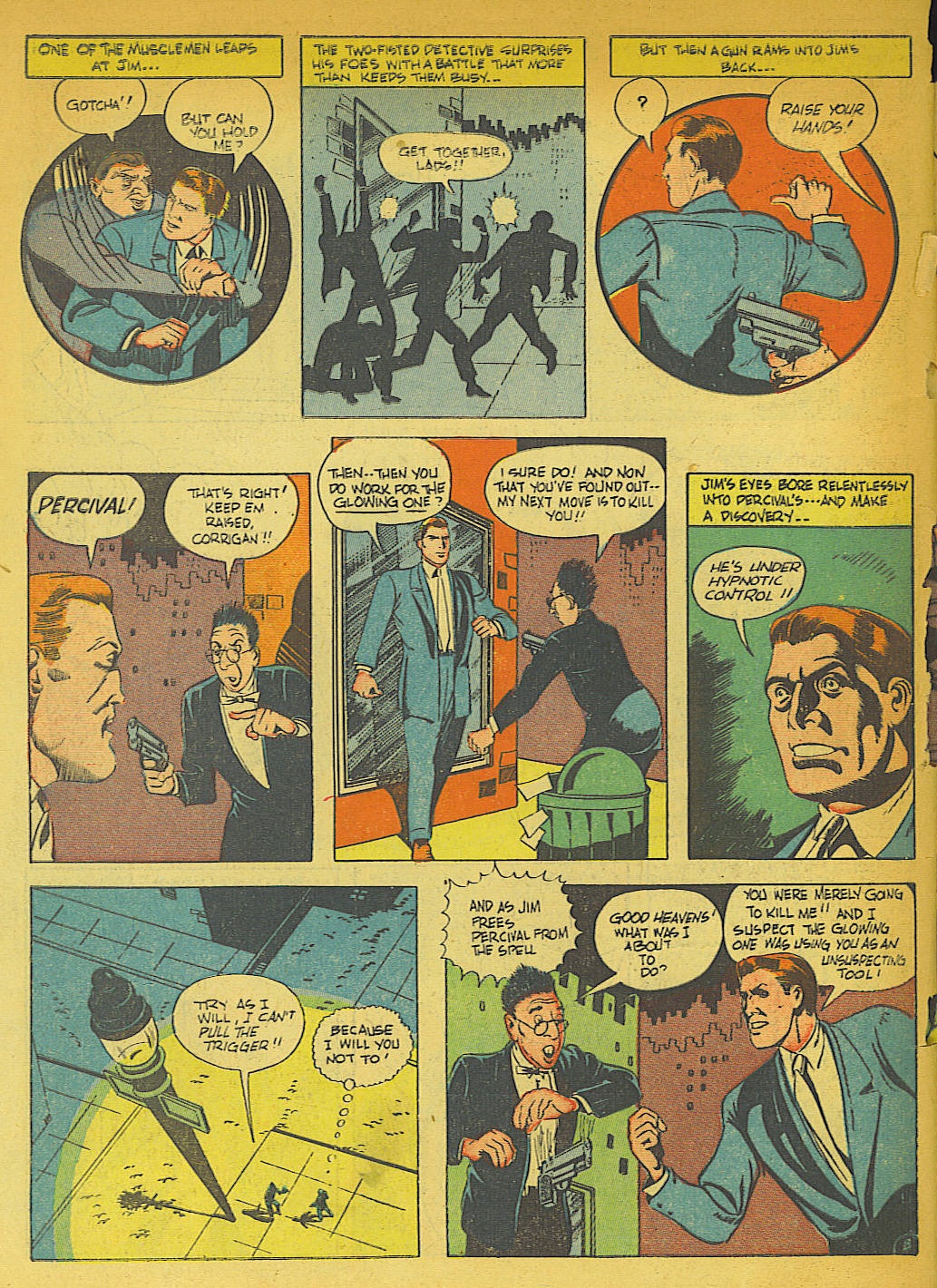 As wonderful as it would be to see the detective turn Popp to ash, he instead determines that the pest is acting under the hypnotic command of his prey. Corrigan wills Popp to not pull the trigger and freeing him from his spell offers him the chance to help him out. Telling him to continue with his act with Lugi, Corrigan advises him to maintain a mental image of The Spectre at all times – advise which Popp follows when Lugi attempts to hypnotize before the show backstage. When the performance proceeds as it always has – Popp going through the audience to ask questions which Lugi will use his magical powers to answer – the diminutive assistant catches on to the scam as he himself unwittingly conducts it by stealing valuables from those audience members he encounters on the floor. You see, Lugi is The Golden One and through the mass hypnotism, has been making his other self appear wherever and whenever he wills it. Even as The Spectre confronts him with this truth backstage, it seems as if Popp is still acting under his command. However, with no real skills, Lugi is unable to offer any resistance when The Spectre flies him to Police HQ rather anticlimactically. The Chief fails to catch The Spectre, Corrigan appears to ask him about this, the detective is told that capturing the ghost is his responsibility, and once again, the tale ends with our hero in human form reminding Popp that he has no interesting in working with him again. 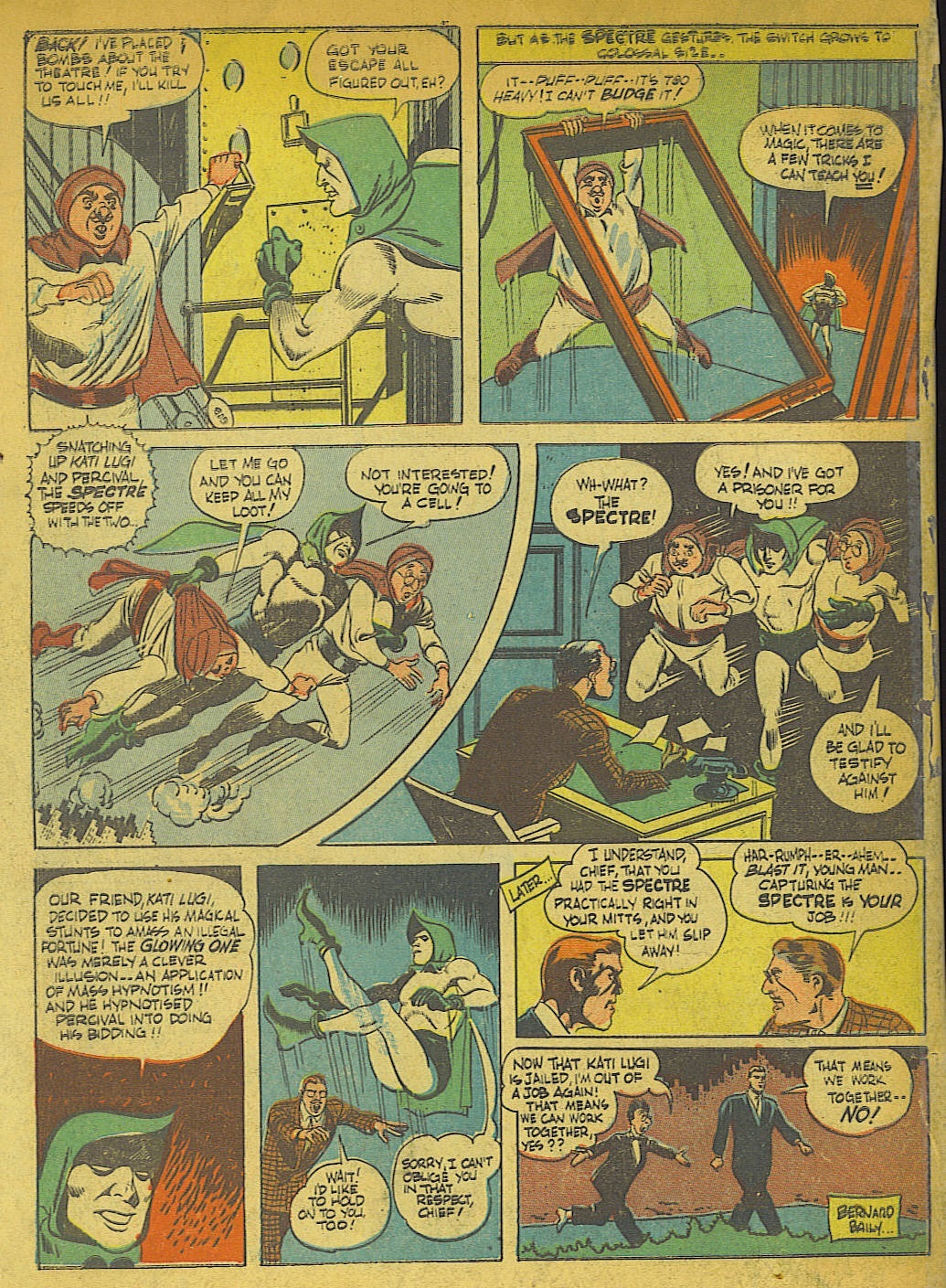 Thoughts Thoughts: Though limited to only a few panels here and there and another impressive splash page to open the story, Baily has been adding greater theatrical touches to his work over the past several months and this issue is no exception. Incorporating both his and Siegel’s name alongside that of The Spectre and Popp’s in a giant marquee on that introductory page isn’t a trick he’s employed in past installments of this series. It’s like something out of Jack Cole or Will Eisner’s playbook and Baily broadening his style in this way is a touch I appreciate. Even the posture of The Glowing One in this splash with his arms and legs splayed apart, bulging eyes, elongated fingers as well as similar characteristics featured on Kati Lugi at various times throughout this tale and the slanted bird’s eye view of a lamp post, has me convince that Baily is paying attention to what other artists are doing elsewhere. A great change from when I once described Baily’s work as “perfunctory” and straightforward. Of course, he’s always shown a penchant for adding little cartoony elements here and there (his tendency for drawing planets and stars like something out of a kid’s book; hair standing on end to convey fear; hats popping off heads to illustrate surprise) so it’s not an entirely unexpected change, but I do wonder if Baily is an artist drawn more to taking a more realistic approach to his work who is now altering his style to fit the lighthearted adaptations made to the strip, or a comical artist who altered his style in those early days to suit a feature which called for something darker. Of course, as Rob Allen noted, we’re not even sure that Baily isn’t using ghosts to handle this artwork. Unless Baily had a habit of relying on uncredited artists to the extent that someone like Bob Kane did, I’m going to guess that this is his work because as his later work would prove, he certainly had no difficulty with regards to adapting his style when he felt the situation called for it. Story wise, Siegel hasn’t done much to adapt to the recent changes he himself incorporated within this series in recent months. Though Corrigan is now human, you wouldn’t know that if you had skipped the two issues which referenced this change. While he is now free to marry Clarice Winston – once a motivating goal for the character in his desire for a normal life – there’s no indication that the young lady even exists anymore. It’s frustrating that Siegel ignored Corrigan’s relationship with Winston for the longest time only to revisit it, commit to a new direction, and then forget about it all over again. Frankly, I don’t really care what Jim Corrigan’s love life is like, but I can’t decide if Siegel ever cared himself or was just adhering to the standard ‘One identity loves the girl; other identity prevents him from acting on that’ trope until an idea popped into his head. Looks like none ever did. One new detail which has stuck of course, is the presence of Percival Popp, Super-Cop. At first I had assumed that Popp was introduced to inject some comedy into this series, but there still aren’t the pratfalls, slapstick, misunderstandings that one associates with comic relief to be found in the character. No attempt at comedy is made when Popp becomes Lugi’s assistant, is suspected of being The Glowing One himself, and he’s not really involved in the action unless you count his being carried around by The Spectre at tale’s end to be of interest. Baily’s rendering of Popp is so over-the-top that I have no choice but to believe he was brought on-board to make us laugh, but really, he’s just obnoxious for the sake of being obnoxious which I can’t imagine anyone found enduring. I don’t know – kids like to nag adults and are bolstered on in their efforts when they see how consternated their targets get, so maybe they find that trait appealing in Popp, but I don’t know how much I would have been able to take of this when I was ten. As for the story itself… For once, Siegel doesn’t really play the villain up as capable of presenting himself as more of a threat than he should be – there’s none of the usual ‘First two rounds go to the bad guy; The Spectre wins round three’ stuff and in fact neither The Glowing One nor his true self as Kati Lugi can do anything against our hero, but I would have appreciated greater attempt being made to explain just how The Glowing One existed at all. “Mass hypnotism” shouldn’t work the way it does here. Yes, a lot of things in comics shouldn’t work the way they do, but if clear effort has been made to explain things in even an unbelievable manner, then I think readers should excuse any logical failings if the explanation is at least clever. This however, is just lazy. Balloons, flash paper, ventriloquism, phosphorescent paint on curtains, etc. might not be exactly credible, but it would at least had made it clear that the writer was involved in his story. Having Popp presented as the criminal mastermind was of some interest but the matter was wrapped up a little too quickly to serve as much of a mystery. Beyond that, I haven’t much to add – I did like The Spectre tossing a bunch of crooks into a police van after growing to enormous size, but otherwise there isn’t any of the usual creative flair with which he exhibits when displaying his incredible powers – just the basic flight, invulnerability to bullets, and the weird way he flies away at the end by bringing his legs up to his chest and daintily pointing his toes towards the sky. So nothing really bad about this tale, but little that I feel is notable either.
|
|
|
|
Post by Cei-U! on Apr 30, 2020 21:08:18 GMT -5
Although his byline continued to appear for a time, Jerry Siegel turned over scripting duties on the Spectre series to Gardner Fox as of More Fun #72.
Cei-U!
I summon the secret substitution!
|
|
|
|
Post by chadwilliam on Apr 30, 2020 22:39:56 GMT -5
Although his byline continued to appear for a time, Jerry Siegel turned over scripting duties on the Spectre series to Gardner Fox as of More Fun #72. Cei-U! I summon the secret substitution! Cei-U! brought this fact to my attention yesterday over at the ' Gardner Fox' thread and yet you'll note that my review from this evening still credits (or blames) Siegel for the story. It's an oversight on my part due to my having written the review several days ago despite posting it a few hours ago. Although I'll be adding a notation drawing attention to Cei-U!'s update to that post, I'll be otherwise leaving it as is because my mistaken assumption that Siegel was still writing this series directly ties in with the confusion I express in the above post (and many of my other reviews since the introduction of Percival Popp, which if the significance of More Fun #72 isn't immediately apparent, the last issue of this series to be Popp-free with the exception of issue 77). Changing the post would mean altering a review which is meant to convey my impressions immediately after reading or re-reading the story. Since that issue left me with a lot of questions, I'll leave it alone rather than retroactively and redundantly answer those questions while posing them. Why would Siegel bring back Clarice Winston, remove the impediment to their being married, return Corrigan to the land of the living, and then ignore these changes two issues later? He didn't - Fox did. Why did Fox do these things? No idea unless he felt that in taking over the strip he should wrap up those loose ends leaving him with a fresh slate. Not a very satisfying explanation since Clarice should now be more prominent than ever in this feature and Corrigan being alive should be receiving more attention than it has, but there is a 'And Jim and Clarice lived happily ever after' feel at the close of More Fun #75 which feels like the end of an era. My thanks to Cei-U! whose Voice like omnipotence is worth one hundred Rings of Life in my book! |
|


